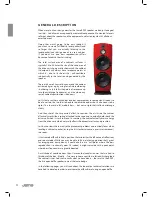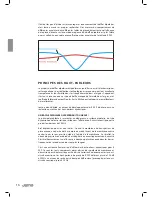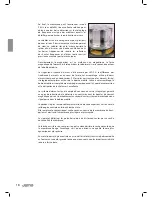
4
G E N E R A L D E S C R I P T I O N
When we set out our design aims for the Jamo R 909 speaker we had just one goal
in mind… to deliver an exceptionally memorable experience. We wanted listeners
to forget about the speakers and the equipment and just enjoy what it’s all about…
entertainment.
Doing that wasn’t going to be easy though. If
you want to create full fi delity loudspeakers (and
so forget that you are actually listening to the
loudspeaker) your design needs to use a cabinet.
If you don’t use one, bass reproduction suffers
because of acoustic ‘short-circuiting’.
The total surface area of a cabinet’s surfaces is
typically 20 to 50 times the size of the cone area of
the drive units. So, no matter how much the cabinet
is damped it will always have resonance points at
which it – due to its sheer size – will contribute
substantially to the total sound generated by the
speaker.
There are fi xes of course. You can make the cabinet
extremely rigid – e.g. by using lots of internal bracing
- but doing so just shifts the points of resonance up
into the midrange frequencies, an area where any
sort of cabinet contribution is bad news.
So, it’s fair to say that any cabinet involves compromises to some extent: It needs to
be of a certain size in order to be able to deliver deep bass but it also needs to be
rigid if it is to avoid a ‘fat’, wobbly bass… but not so rigid that it affects midrange
clarity.
And then there’s the ‘suspension’ effect to consider. The air inside the cabinet
effectively works like a ‘spring’ attached to the cone and so actually holds back the
driver unit when it starts to move. In summary, the cabinet actually drains energy
from the drive units which naturally affects the dynamics, attack and precision.
Last but not least there are also the placement problems one routinely faces when
locating a cabinet speaker (or, to give it its technical name, a pressure transducer)
in a room.
It’s extremely diffi cult to fi nd a position that minimizes the infl uence of refl ections
and room modes. While you may be able to fi nd a listening position that’s great
for imaging and transparency it could also be at a ‘null’ point where the bass
reproduction is extremely poor. Or indeed, it might coincide with a peak point
where bass frequencies are greatly boosted.
A multitude of considerations then. Our eventual conclusion was that we had to
think ‘out of the box - literally - if we were to come up with a solution which avoided
the cabinet issues. And that’s exactly what we have done… the result is the R 909,
the fi rst open baffl e speaker to wear the Jamo badge.
In the following pages you will read about the innovative technical solutions we
have had to develop in order to overcome the diffi culties of using an open baffl e.
Содержание R 909
Страница 1: ...TECHNICAL DESCRIPTION Jamo R 909 ...
Страница 2: ...français deutsch english ...
Страница 3: ...2 english ...
Страница 13: ...français ...
Страница 23: ...deutsch ...
Страница 33: ...32 ...
Страница 34: ...33 ݙ ᆍ ὖ䗄 ي ᵕᓣ ㆅ ᠓䯈 偅ࡼॳ ϔϾ ي ᵕᓣ ㆅг㛑ѻ 䞡Ԣ 偅ࡼऩ ܗ Ԣ Ё 催 ߚ乥 ࠡ䱰ᵓ ᘏ㒧Ă 㾘Ḑ ...
Страница 42: ...www jamo com ...






































